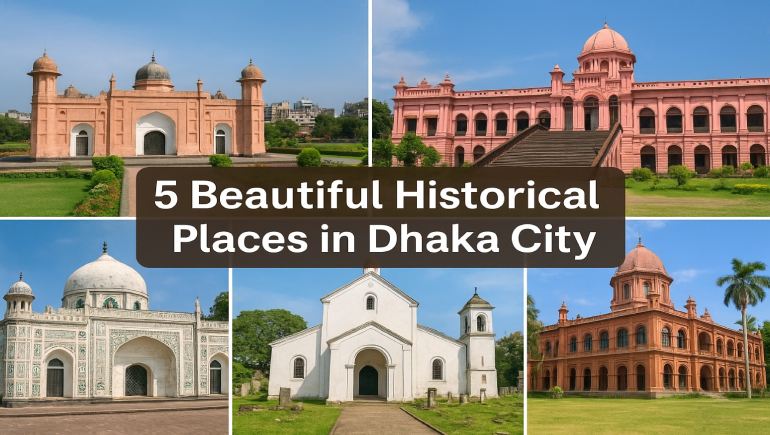
Dhaka, the bustling capital of Bangladesh, is a city that beautifully blends modern life with a rich historical past. Its streets and monuments tell tales of royal dynasties, colonial rule, and cultural evolution. Here’s a detailed look at five beautiful historical places in Dhaka, highlighting their history, architecture, and cultural significance.
Lalbagh Fort, located in the Old Dhaka area, was commissioned in 1678 by Mughal subahdar Shaista Khan. Unfortunately, it remained unfinished after the death of Pari Bibi, the daughter of the fort’s builder. The complex includes the Diwan-i-Aam (public audience hall), a mosque, and a tomb surrounded by carefully designed Mughal-style gardens. The fort’s red-brick walls, arched gateways, and terraced gardens reflect the grandeur of Mughal architecture.
Lalbagh Fort is a symbol of Dhaka’s Mughal heritage and attracts history enthusiasts, photographers, and tourists. Its gardens provide a serene escape from the city’s hustle, while the tomb of Pari Bibi adds a touch of historical mystery, making it one of the most visited landmarks in Dhaka.
Ahsan Manzil, famously known as the Pink Palace, was built in the 19th century by Nawab Khwaja Abdul Ghani. Originally serving as the residence of Dhaka’s Nawabs, the palace is a fine example of Indo-Saracenic architecture with European and Mughal influences. Its grand ballroom, ornate wooden staircases, and intricately decorated ceilings showcase the luxurious lifestyle of Dhaka’s elite during the colonial period.
Ahsan Manzil represents Dhaka’s royal heritage and is significant for its historical artifacts, royal memorabilia, and cultural exhibitions. Its location along the Buriganga River and pink-colored façade make it a visual icon of the city. Today, it functions as a museum, educating visitors about Dhaka’s past and the Nawabs’ influential role in society.
Built in the early 19th century by a wealthy merchant named Mirza Golam Pir, the Star Mosque is renowned for its distinctive star-shaped motifs made from blue and white mosaic tiles. The mosque combines traditional Islamic architecture with local artistic creativity, featuring multiple domes, decorative pillars, and a beautifully designed mihrab.
The mosque is celebrated for its unique design, intricate tile work, and spiritual ambiance. It stands as a remarkable example of Dhaka’s religious architecture and is frequently visited by both worshippers and tourists who admire its artistic beauty. Its delicate mosaics and star patterns make it one of the most photographed landmarks in the city.
Built in 1781, the Armenian Church of the Holy Resurrection served the Armenian Christian community that once lived in Old Dhaka. The church is constructed in simple yet elegant colonial-style architecture, with arched windows, whitewashed walls, and a modest altar. Surrounding the church are historic tombstones engraved with Armenian inscriptions, narrating the lives of the community members who contributed to Dhaka’s trade and culture.
This church is a rare glimpse into the multicultural past of Dhaka. It preserves the memory of the Armenian merchants and their influence on the city’s commerce and social life. It is significant not only as a place of worship but also as a cultural heritage site, reminding visitors of Dhaka’s cosmopolitan history.
Constructed during British colonial rule, Curzon Hall is part of the University of Dhaka campus. Named after Lord Curzon, the Viceroy of India, it was originally built for the Faculty of Science. The building showcases Indo-Saracenic architecture, blending Mughal domes and arches with European structural elements. Its large lecture halls, elegant corridors, and open courtyard are reflective of the educational and intellectual environment of Dhaka during colonial times.
Curzon Hall is not just an architectural marvel; it played an important role in the Bengali Language Movement and remains a symbol of education, culture, and resistance. Students, historians, and photographers flock here to admire its design and learn about its role in Dhaka’s academic and social history.
Dhaka’s historical landmarks offer far more than aesthetic beauty—they are windows into the city’s rich heritage and diverse past. Each site tells a unique story, from Mughal grandeur and royal elegance to multicultural coexistence and colonial influence. Exploring these places allows both locals and visitors to connect deeply with the history, culture, and identity of Dhaka, making it a city that truly celebrates its past while thriving in the present.












Comments
There are no comments for this Article.